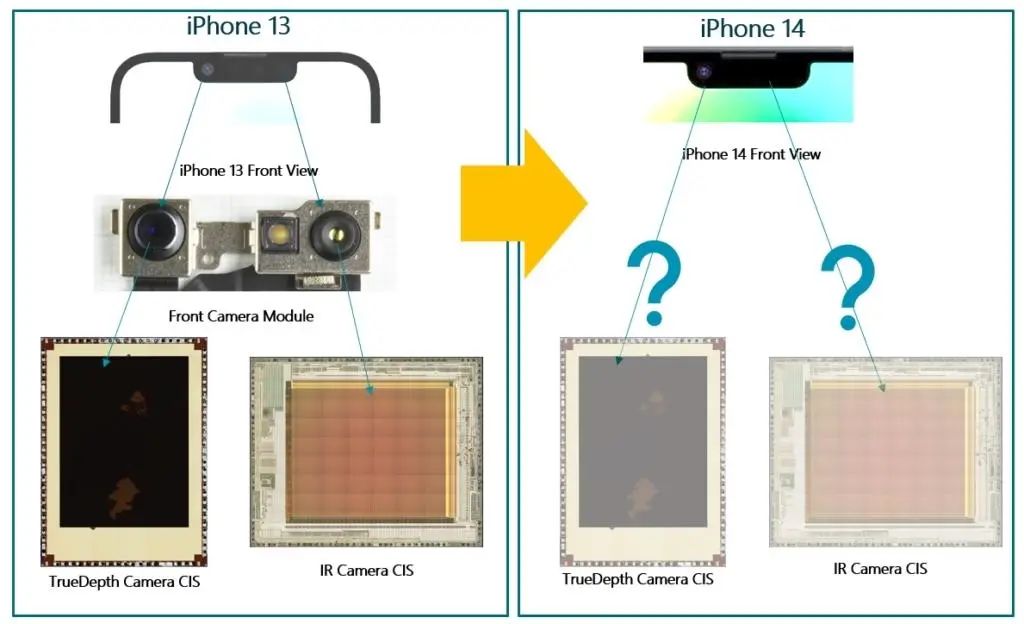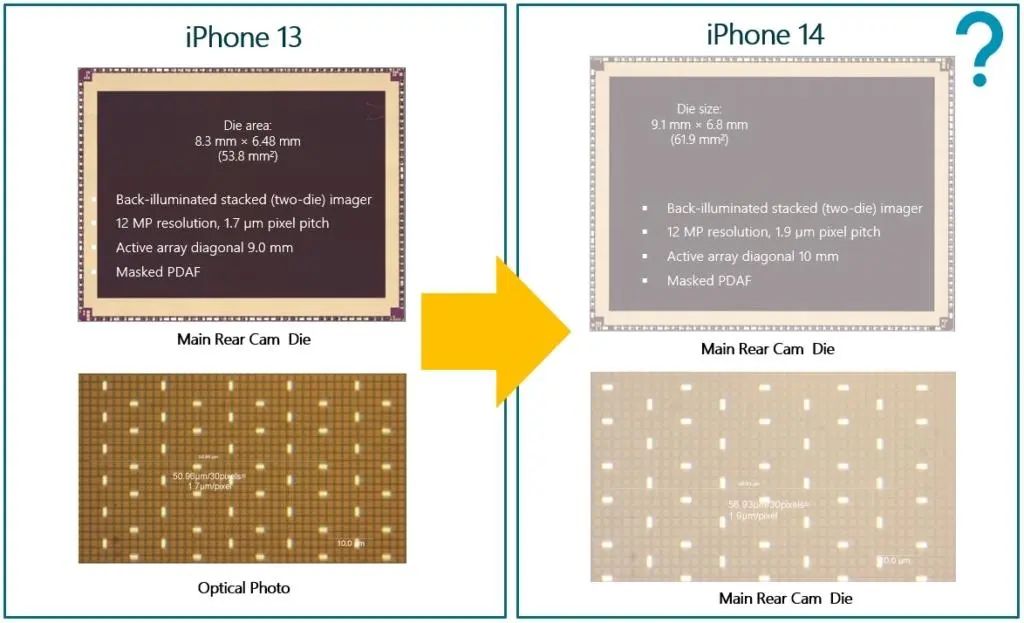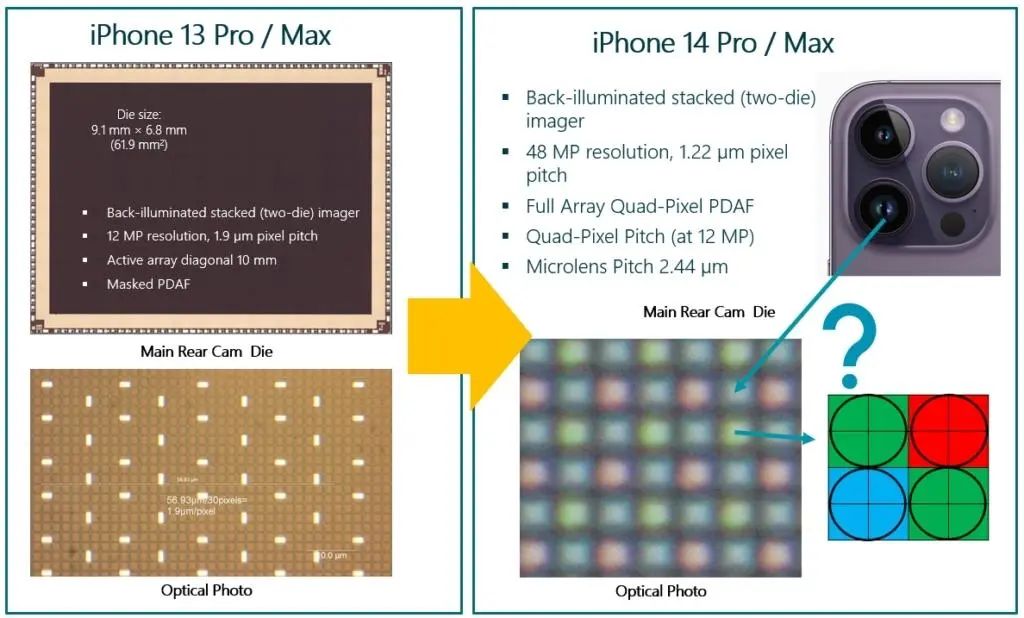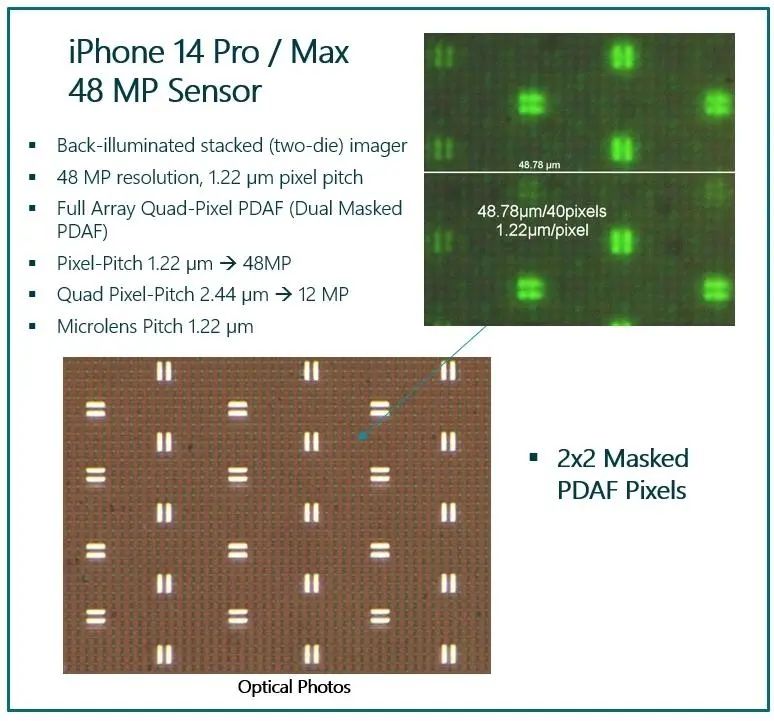Skip to content

In the recently released iPhone 14 series by Apple, the main rear camera of the basic iPhone 14 has been upgraded. Meanwhile, in the flagship iPhone 14 Pro/Pro Max, not only has the long-awaited rear camera resolution been upgraded, but the front camera module has also been enhanced.
The well-known technical analysis firm TechInsights has dissected the front and rear camera modules of the entire iPhone 14 series, detailing the upgrades in the image sensor.
From the disassembly shown in the image below, it appears that the front camera module of the Apple iPhone 14 and 14 Plus is similar to that of the iPhone 13, at least in terms of the notch layout, where the position and shape of the notch are basically the same. Therefore, it can be inferred that the original TrueDepth camera and Face ID IR camera/emitter used in the new iPhone 14/14 Plus may be the same sensors as those used in the iPhone 13 series (Figure 1).
Figure 1. Comparison of the front camera modules of the Apple iPhone 13 and iPhone 14.
Compared to the basic model, Apple has redesigned the front camera module for the high-end iPhone 14 Pro/14 Pro Max, naming the new design “Dynamic Island”. The previously opaque area of the “pill-shaped” region for the front TrueDepth and infrared cameras is no longer just a notch but appears to have “expanded”, giving the illusion that it is part of the display. TechInsights considers this to be a great feature that reduces the visual footprint of the front camera module.
The image below is a high-contrast image comparing the front camera modules of the iPhone 13 and iPhone 14 Pro/14 Pro Max, showing two main areas: one for TrueDepth and the other for the IR camera/emitter component. The iPhone 14 Pro/14 Pro Max module has been redesigned to be more compact. The casing of the IR camera seems to be the same as that in the iPhone 13 Pro/13 Pro Max, but the casing of the TrueDepth camera looks somewhat different (Figure 2).
Figure 2. Comparison of the front camera modules of the iPhone 13 and iPhone 14 Pro/14 Pro Max.
Compared to the pixel size of 1.7 µm in the rear camera of the previous generation iPhone 13, the main rear camera of the iPhone 14/14 Plus has been upgraded to a sensor with a pixel pitch of 1.9 µm. However, this larger pixel size sensor seems to be a reuse of the rear camera from last year’s iPhone 13 Pro/13 Pro Max (using last year’s high-end camera in this year’s basic model). Figure 3 compares the two sensors from the two years’ basic models, both of which employ 12MP Masked PDAF technology.
Figure 3. Sensors of the main rear cameras of the iPhone 13 and iPhone 14.
One of the most striking new features introduced by Apple this year is the upgraded main rear camera sensor resolution in the iPhone 14 Pro/14 Pro Max, reaching 48MP. Reports indicate that this quad-pixel sensor has a pixel pitch of 2.44 µm. In other words, the absolute pixel pitch of this sensor at 48MP resolution is 1.22 µm, while at 12MP resolution it is 2.44 µm. Interestingly, the quad-pixel can also revert to Apple’s traditional 12MP resolution, providing full-array autofocus, a new feature introduced by Apple.
Compared to traditional partial Masked PDAF methods, full-array autofocus improves image quality as there are more pixels to provide PDAF signals, especially in low light conditions. TechInsights speculates that the main rear 48MP sensor provides a pixel pitch of 2.44 μm for 2×2 macro phase detection (Figure 4).
Figure 4. Main rear cameras of the Apple iPhone 13 Pro/Max and Apple iPhone 14 Pro/Max with the new 48MP sensor.
In fact, TechInsights’ recent analysis of the iPhone 14 Pro/14 Pro Max indicates that this new 48MP sensor is similar to its predecessor as it also uses Masked PDAF. As always, Apple only adopts incremental enhancements, and Masked PDAF seems to be their preferred method. Additionally, dedicated autofocus pixels are now arranged in a 2×2 manner, as shown in Figure 5.
Figure 5. The new 48MP sensor of the main rear camera of the Apple iPhone 14 Pro/Max.
In addition to the new 48MP rear camera, it is rumored that the ultra-wide camera in the iPhone 14 Pro/14 Pro Max also features full-array autofocus pixels, but preliminary images of the pixel array provided by TechInsights confirm otherwise. The image sensor of the ultra-wide camera in the iPhone 14 Pro/Max seems to be the same as that of the iPhone 12 Pro’s main rear camera (and may be reused), which is a Sony sensor with a pixel pitch of 1.4 µm and 12MP resolution. Figure 6 shows side-by-side optical photos of the two cameras, confirming that the ultra-wide camera in the new model uses Masked PDAF.
Figure 6. Comparison between the main rear camera of the iPhone 12 Pro and the ultra-wide rear camera of the iPhone 14 Pro/Max, both having a pixel pitch of 1.4 µm and 12MP resolution.
TechInsights also plans to conduct DEF/DEP and EXR analysis on the image sensors of the Apple iPhone 14 series, hoping to provide clearer details after the analysis is completed. We will continue to monitor.
IIC Shenzhen, Scan to Register















